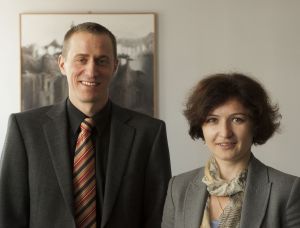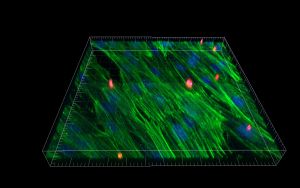Cancer researcher Dr. Irina Nazarenko and the engineer Dr. Stefan Giselbrecht from KIT are granted a science award for cancer research without animal experiments by the Association of Doctors against Animal Experiments. The two researchers are honored for modeling the growth of human cells on microstructured biochips, by means of which they study the mechanisms associated with metastasis formation of breast cancer in bone tissue. Based on the results obtained from their project conducted under the BioInterfaces Programme, new approaches to controlling stem cell behavior and to innovative cancer therapies shall be developed.
Representatives of the media are invited to come to the award ceremony that will take place tomorrow, Wednesday, August 10, 11 hrs, at the Institute for Biological Interfaces (IBG 1) on KIT Campus North, building 601. The Association of Doctors against Animal Experiments honors cancer research activities without any animals or animal material. Also nutrient media for cell cultures and antibodies are produced synthetically. The award is endowed with an amount of EUR 10,000. “We are pleased to support scientists, whose research activities allow for man-related tumor-specific studies without any animal having to suffer,” says the biologist Silke Bitz from the Association.
The KIT scientists Dr. Irina Nazarenko from the Institute of Toxicology and Genetics (ITG) and Dr. Stefan Giselbrecht from the Institute for Biological Interfaces (IBG 1) combine methods of cell research with engineering sciences in their interdisciplinary project under the BioInterfaces Programme. They study how metastases of a tumor develop by analyzing communication among cells. In metastasis development, the formation of so-called pre-metastatic niches plays a decisive role: Tumor cells obviously can modify normal cells of the body such that fertile ground is prepared in certain organs, e.g. the lungs, the liver, and the bones. In these pre-metastatic niches, circulating tumor cells can settle and develop metastases.

Dr. Stefan Giselbrecht (IBG1), Dr. Inrina Nazarenko (ITG)
The research teams of Nazarenko and Giselbrecht study the still unknown molecular mechanisms of communication among tumor cells and between the tumor and the body of the patient, especially the adult stem cells. Above all, it is aimed at specifically controlling the stem cell behavior by cellular communication. For this purpose, the researchers developed a model of the pre-metastatic niche of the mamma carcinoma in the bone tissue. They cultivate human cells on microstructured biochips in bioreactors. In this way, they reproduce the processes of interaction of cells with the niche in the bone tissue truly to life.
To develop a model of the bone marrow, both KIT researchers use new foil-based microstructured cell culture matrixes and miniaturized bioreactors as well as co-cultures of human cells. With the help of chips, they reproduce the architecture of the bone as closely to reality as possible. The chips are produced via the SMART (Substrate Modification and Replication by Thermoforming) process developed by them. To investigate the activation of stem cells of the bone marrow by messenger substances produced by tumor cells, such as soluble molecules or membrane bubbles, Nazarenko and Giselbrecht apply bioreactors with two integrated chips separated by a porous membrane. In the first chip, they cultivate the models of the bone marrow. In the second chip, tumor cells of the human mamma carcinoma are produced.
These activities under the interdisciplinary BioInterfaces Programme for the first time allow to observe and control in-vitro the natural interface of the pre-metastatic niche under controlled conditions. With their model, Nazarenko and Giselbrecht are pioneers in the field of application-oriented micro- and nanotechnologies. On this basis, niches in other organs and for various types of tumors shall be modeled in the future. Findings relating to processes associated with the formation of the pre-metastatic niche and their specific control are of decisive importance to the development of new therapies against metastases.
In close partnership with society, KIT develops solutions for urgent challenges – from climate change, energy transition and sustainable use of natural resources to artificial intelligence, sovereignty and an aging population. As The University in the Helmholtz Association, KIT unites scientific excellence from insight to application-driven research under one roof – and is thus in a unique position to drive this transformation. As a University of Excellence, KIT offers its more than 10,000 employees and 22,800 students outstanding opportunities to shape a sustainable and resilient future. KIT – Science for Impact.

